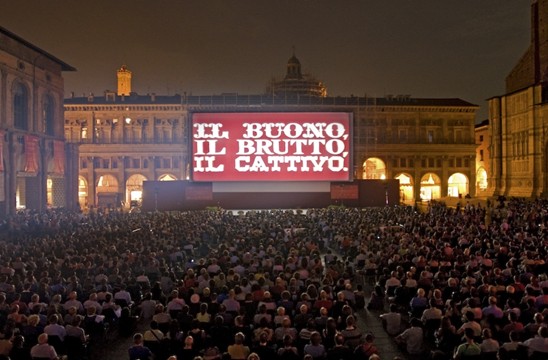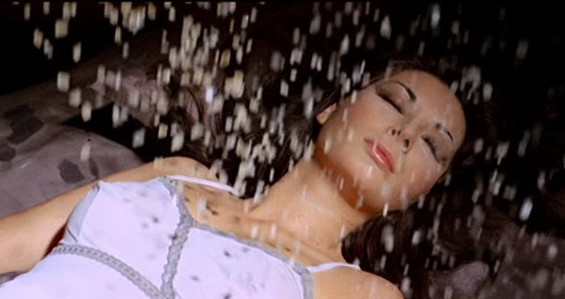
With the switch to digital cinema now nearly five years in the past in the UK, the true value of the way film was shown for the first hundred years is thrown into relief. Yet, despite the ubiquity of digital cinema prints (DCPs), there is a strong resurgence of screenings on film in independent cinemas, from Eastbourne’s Overnight Film Festival to Bradford’s Widescreen Weekend. Is this film’s own ‘vinyl revolution’, or is celluloid only for niche audiences? We asked four curators who are passionate supporters of film on film why the format matters and why everyone should get the chance to regularly see celluloid screenings.
Ian Mantgani, Badlands Collective
What is it about screening on film that makes it an essential experience?
When you see a well-produced film print, properly projected, it still feels like a miracle in the lineage of the magic lantern show. One thing film still has over digital is that it feels alive because it’s light shining through an emulsion, it’s dimensional and because the grain structure is different in each frame, the illusion of movement feels vibrant. Digital cinema now has a decent resolution, yet compared to photo chemical cinema, it’s still comparatively flat and static; colder, if you will. The contrast and colour range in decent film prints are also greater than whats currently available digitally, making the images richer. A projectionist once said to me, 35mm looks like something you can jump into; digital looks like something shined onto something.
Film is also an essential experience because it was the standard screening format for the first century of cinema; I see it as the peoples birthright to be able to view this medium. Now that digital simulacra have become the norm, and celluloid is treated like some elite delicacy… Well, I understand there are economic imperatives at work, but it still feels to me that everyday people have been robbed of nice things that were once normal.
What screening on celluloid first blew your mind or one that’s meant something to you recently?
One of the first prints we screened as The Badlands Collective still stands out as a special moment, and that was Jonathan Glazer’s showprint of Birth,developed on silver nitrate. It was in perfect condition, and had a real shimmering quality. In terms of new movies, I feel grateful to have seen the beautiful prints of Interstellar, The Hateful Eight and Inherent Vice that did the rounds these past few years; my colleague Craig tells me the 70mm print of Batman vs Superman was very good too. Unfortunately it didn’t play long enough for me to see it!
In London we get lots of great repertory cinema. Some of my highlights from the past few months include when the Prince Charles played a never-before-shown print of Nothing Lasts Forever, when the BFI imported some rarely-seen US prints of John Carpenter films like They Live, and when the Curzon unearthed a print of Andi Engels Melancholia. My colleague Phil listed a few recent London 35mm highlights as including Kundun, Millennium Mambo and Lost Highway. All three of us were also lucky enough to attend last years Il Cinema Ritrovato festival in Bologna, where there were a multitude of gems, including the only IB Technicolor print of The Thin Red Line ever made. That’s another special thing about film: prints have their own story and history, which wenbecome a part of when we view them.
To read more about The Badlands Collective and their events, click here.

Tara Judah, critic and programmer
As a bored teen, stranded in the south-eastern suburbs of Melbourne, Australia, I loved melodrama and the tragedy of Shakespeare, but knew little about the movies. Invited by a friend, to a single-screen cinema, to see Kenneth Branagh’s screen adaptation of my favourite Shakespeare play, Hamlet, I ventured out of my two-bit suburb and into an art deco/jazz-moderne cinema building of epic proportions. Inside, behind the glorious gold-curtains, I was treated to a 70mm extravaganza; roaring sound and stunning images that romanced me and so began my deep, profound love affair with film. What made it even more special was that each frame, as it flickered before my eyes, held the love and affection of the projectionist whose hands had laced it up, carefully focused it and made sure it looked and sounded as good as it possibly could, for my enjoyment. I was unsuspecting, on that fateful day, that those very loving hands belonged to someone who would, some fifteen years later, become my mentor, employer and a life-long friend. Film is so much more than just a movie.
And why film is so essential?
It is easy to fall into the false economy of thinking about cinema as a purely visual exploit: pixels that pass in front of our eyes. But cinema is far more sensory than eyeballing images suggests. The true joy and romance of moving images is that they bring multiple senses to life; the touch of the projectionists hands; the physical imprint of his/her finger onto the leader and edges of the film strip that itself holds a physical imprint of the image it once captured, IRL; the stories and aesthetics that touch our souls. What we see, when we see film, isp hotochemically indexed in emulsion, fed through a machine crafted and cared for by human hands and beads of sweat far more moving than a screen full of 0sand 1s. Each time I hear a xenon lamp spark and the whirr of a film projector kicking in, I know I’m in for a treat, because the show is more than just a movie. Each sprocket hole moves in sync with well-oiled beat of our hearts and,as I take up my seat, so continues the rich tradition of touching images, with human hands, sweat, souls and eyes.
To read more of Tara Judah’s writing and more on her curation, click here. She will be leading The State of Things: Film Critics’ Day at Watershed’s Cinema Rediscovered.

RebeccaNicole Williams, curator, The Celluloid Sorceress
What is it about screening on film that makes it an essential experience?
Celluloid is the fundamental basis of cinema. While a modern audience still refers to a long form motion picture as a film so few of them are actually shot on that shiny, translucent strip. Let alone the three of original 3 strip Technicolor! In order to understand what cinema was, and still should be,I think its important to honour the pioneers and champions of the form.Through this we get an understanding of the technical complexities of making a film, but also, if presented correctly, a good presentation from film will also capture for an audience the pride and showmanship of the early exhibitors. With so many notions of event and spectacle still evident in today’s IMAX and large format presentations we can only truly understand how far cinema has come by examining and appreciating the qualities of film making and exhibition gone by, some of which can not be recreated by today’s technology.
What screening on celluloid first blew your mind or one that’s meant something to you recently?
I’m of an age that all my formative cinema experiences were on 35mm film. Ill never forget CE3K at the Royal Concert Hall, Nottingham, the biggest screen in the East Midlands. Or Amadeus. Or the double feature of Broadway Danny Rose and The Purple Rose of Cairo. Or my first 70mm, Apocalypse Now! In some ways my childhood was a bit Cinema Paradiso so I have vivid memories of watching the boys at the local ABC lace up Raiders back on its original release before my 8-year-old-self sat and watched a film that remains a favourite today. More recently 3-Strip Cinerama at Bradfords Widescreen Weekend is a rare experience. And, of course, my own contributions to 35mm programming and those of my programming contemporaries provide magical cinema experiences every week. Good times!
The Celluloid Sorceress’s 35mm Cult Saturday (showing five classic and rare 1980’s films on 35mm film) takes place September 23 at The Cinema Museum in London.

Josh Saco, Cigarette Burns Cinema
There’s an inherent adventure attached to screening films on film. Perhaps more so when you are screening rare prints. You can never be sure of what version you are getting. Sometimes this can be a gift: for instance the Lucio Fulci film One on Top of the Other, which happily was an extended version adding an additional ten minutes of super rare footage.
On the flip side, there are films that are so bogged down in mystery and confusion that the only versions available are heavily bastardised from the film you may be expecting based on its digital counter. However, I argue that this isn’t necessarily a bad thing, in fact its interesting to watch Next! the US cut of Sergio Martino’s classic The Strange Vice of Mrs Wardh. Editorial decisions were made to make the film appeal to a US audience. This doesn’t just include excising the sexy bits, butaltering the introduction of one of the lead characters, re-cutting the story and effectively making it even more nonsensical than it began.
I find these choices interesting. It’s fun to see what people did or didn’t do to a favourite film. These differing versions are unlikely to ever be digitised as we enter into the world of Ultimate Most Complete Edition Blu-rays, and a fan base who are hyper sensitive to perceived cuts.
But often times, these films were introduced to their audiences in these ways,these are the versions that won awards, acclaim, fans and ultimately created the legacy that we cherish.
New transfers involve recolouring; 4K remasters where creatives go back and fix problems. These all effectively change history, alters our relationship with the art in its original form.
Celebrating film on film is complex: its not as simple as digital vs. celluloid, but celluloid is our past no matter how you approach it,and that alone makes it worth saving, tending to and caring for.
Cigarette Burns’ Into the Woods programme of folk horror is currently taking place at the Barbican in London. To find out more about the season and future screenings, click here.

